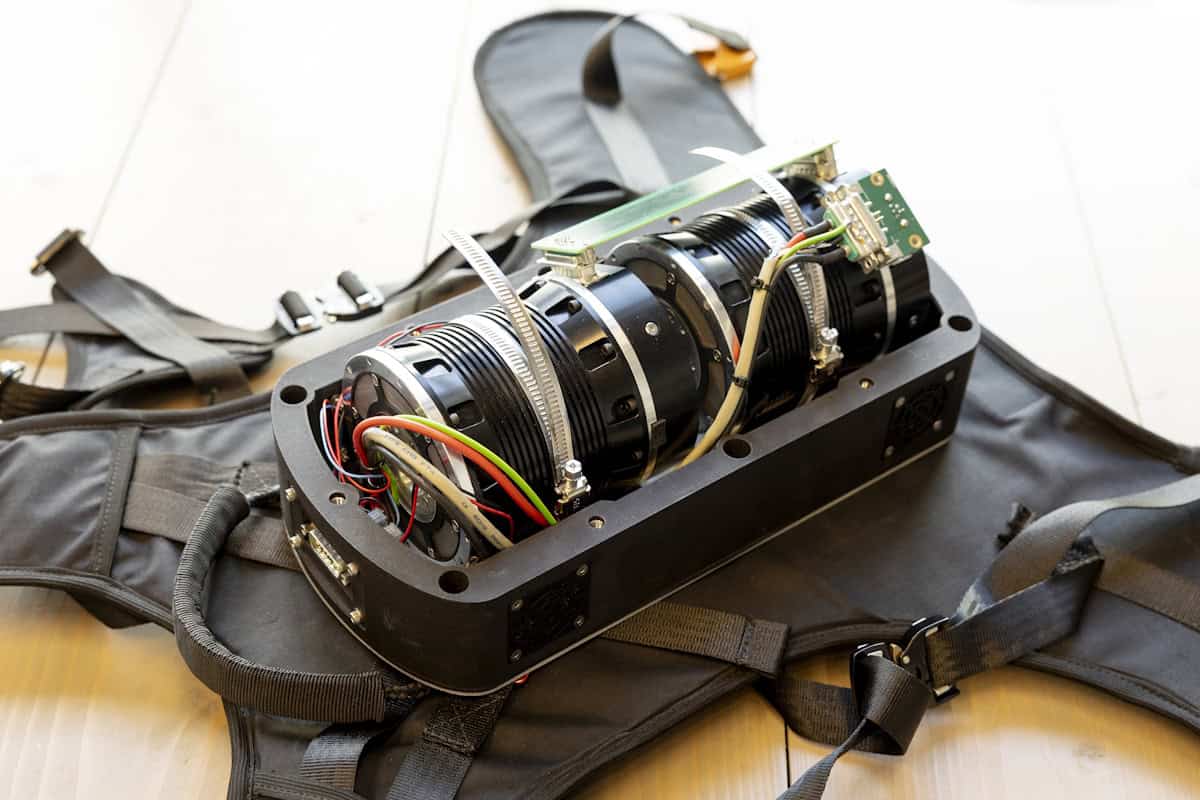Science
Robotic Gyroscopic Backpack Enhances Stability for Ataxia Patients

A new robotic backpack known as the GyroPack has demonstrated potential in enhancing stability for individuals suffering from severe balance issues, specifically those diagnosed with movement disorders such as ataxia. This innovative device, which incorporates gyroscopic technology akin to that used in satellites, aims to improve balance and may eventually eliminate the need for traditional mobility aids like walkers.
The GyroPack has been under development for over a decade by a multidisciplinary team of experts, including neurologists, biomechanical engineers, and rehabilitation specialists from Radboud University Medical Centre, Delft University of Technology, and Erasmus Medical Centre. The initial trials assessing its efficacy were published in the journal npj Robotics, showcasing promising results that warrant further exploration into its use as a portable robotic wearable for those with neurological conditions.
Degenerative ataxias, which encompass various diseases of the nervous system, lead to progressive dysfunction characterized by symptoms such as lack of coordination and difficulty maintaining balance. These conditions can affect individuals across all age groups, including children. Often, managing the symptoms requires long-term reliance on cumbersome walkers, which can hinder mobility and independence.
The GyroPack, weighing approximately 6 kg, is equipped with two control moment gyroscopes (CMGs) that serve as attitude control devices. These CMGs consist of flywheels and gimbals that generate changes in angular momentum, helping to stabilize the wearer’s torso and resist unintended movements. Additionally, the backpack features two independent miniaturized actuators, each weighing 1.5 kg, designed to convert energy into motion. The device is operated via a laptop and includes a power box for safety, ensuring that all activities can be halted immediately by pressing an emergency stop button.
Jorik Nonnekes, the lead researcher from Radboud UMC, explained the mechanics behind the GyroPack: “The change of orientation imposed by the gimbal motor, combined with the angular momentum of the flywheels, causes a free moment, or torque, that is exerted onto the system the CMG is attached to – which in this study is the human upper body.” He further noted that the control system effectively dampens rotational motion, making balance easier for both healthy individuals and those recovering from strokes.
Performance Trials and Future Directions
In a recent study, 14 participants diagnosed with degenerative ataxia were tasked with performing various exercises while wearing the GyroPack. These included standing still with feet together, walking on a treadmill, and executing 360-degree turns. The participants completed these exercises under three different conditions: wearing the GyroPack in assistive mode, wearing it in a sham mode without active assistance, and a baseline condition without the device.
The findings revealed that when the GyroPack was fully operational, users experienced a significant increase in their average standing time compared to not wearing the backpack. Furthermore, while walking, the device reduced the variability of trunk angular velocity and the extrapolated centre-of-mass, both critical indicators of gait stability. Notably, even during the sham mode, participants performed better in certain tasks than when not using the backpack, which researchers attribute to the potential stabilizing effect of the added weight or perhaps a placebo effect.
Looking ahead, the research team aims to enhance the GyroPack by making it lighter and more discreet for daily use. Nonnekes expressed optimism about the device’s future applications, stating, “It’s not yet suitable for everyday use. But in the future, it could help people with ataxia participate more freely in daily life, like attending social events without needing a walker, which many find bulky and inconvenient. This could greatly enhance their mobility and overall quality of life.”
The GyroPack represents a significant step forward in assistive technology, potentially transforming the lives of individuals living with mobility challenges due to ataxia and similar conditions. As research continues, the hope is that innovations like this will lead to improved independence and quality of life for those affected.
-

 Entertainment3 months ago
Entertainment3 months agoAnn Ming Reflects on ITV’s ‘I Fought the Law’ Drama
-

 Entertainment4 months ago
Entertainment4 months agoKate Garraway Sells £2 Million Home Amid Financial Struggles
-

 Health3 months ago
Health3 months agoKatie Price Faces New Health Concerns After Cancer Symptoms Resurface
-

 Entertainment3 months ago
Entertainment3 months agoCoronation Street’s Carl Webster Faces Trouble with New Affairs
-

 Entertainment3 months ago
Entertainment3 months agoWhere is Tinder Swindler Simon Leviev? Latest Updates Revealed
-

 Entertainment4 months ago
Entertainment4 months agoMarkiplier Addresses AI Controversy During Livestream Response
-

 Science1 month ago
Science1 month agoBrian Cox Addresses Claims of Alien Probe in 3I/ATLAS Discovery
-

 World2 weeks ago
World2 weeks agoBailey Announces Heartbreaking Split from Rebecca After Reunion
-

 Health4 months ago
Health4 months agoCarol Vorderman Reflects on Health Scare and Family Support
-

 Entertainment4 months ago
Entertainment4 months agoKim Cattrall Posts Cryptic Message After HBO’s Sequel Cancellation
-

 Entertainment3 months ago
Entertainment3 months agoOlivia Attwood Opens Up About Fallout with Former Best Friend
-

 Entertainment2 weeks ago
Entertainment2 weeks agoCoronation Street Fans React as Todd Faces Heartbreaking Choice









